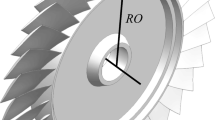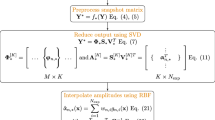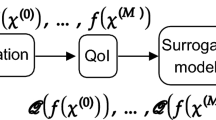Abstract
We combine multiple sets of variable-precision full-field simulations within a single surrogate model. The approach is based on an original formulation of the “Constrained Proper Orthogonal Decomposition” (C-POD), interpolating precise, albeit costly, high-fidelity data and approximating abondant, yet less accurate, lower-fidelity data. We compute the optimal high-dimensional subspace spanning the sparse high-fidelity full-field solutions and refine the output subspace definition thanks to the orthogonal information contained in abondant low-fidelity full-field solutions. We then build “hierarchised” multi-fidelity surrogate models based on the previously refined subspace and giving a fast estimation of the high-fidelity full-field solution of any new location in the design space. The proposed model is illustrated by exploring the prediction of an analytical 2D functional space on the one hand, and demonstrated by studying the efficiency of a 1.5-stage low-pressure compressor on the other.


























Similar content being viewed by others
References
Balabanov V, Grossman B, Watson L, Mason W, Haftka R T (1998) Multifidelity response surface model for hsct wing bending material weight Multidisciplinary analysis optimization conferences. American Institute of Aeronautics and Astronautics. doi:10.2514/6.1998-4804
Bishop C M (1995) Neural networks for pattern recognition. Advanced texts in econometrics. Clarendon Press
Bui-Thanh T (2003) Proper orthogonal decomposition extensions and their applications in steady aerodynamics. Master’s thesis, Ho Chi Minh City University of Technology
Cambier L, Heib S, Plot S (2013) The onera elsa cfd software : input from research and feedback from industry. Mechanics & Industry 14(3):159–174. doi:10.1051/meca/2013056
Chen P P, Yang Q W, Farhan Ali S, Hashmi P J S, Zhao L (2012) Passive control of hub-corner separation/stall using axisymmetric-hub contouring, 226, pp 1214–1224. doi:10.1177/0954410011421716
Colombo E (2011) Investigation on the three-dimensional flow mechanisms in annular axial compressor cascades for aero engines with flow control by aspiration on the hub and on the blades. PhD diss, STI, Lausanne. doi:10.5075/epfl-thesis-5241
Dorfner C, Hergt A, Nicke E, Moenig R (2011) Advanced non-axisymmetric endwall contouring for axial compressors by generating and aerodynamic separator - part i: Principal cascade design and compressor application. J Turbomach 133(2):21–26. doi:10.1115/1.4001223
Filomeno Coelho R, Breitkopf P, Knopf-Lenoir C (2008) Model reduction for multidisciplinary optimization - application to a 2d wing. Struct Multidiscip Optim 37(1):29–48. doi:10.1007/s00158-007-0212-5
Forrester A I J, Keane A J (2009) Recent advances in surrogate-based optimization. Prog Aerosp Sci 45 (1-3):50–79. doi:10.1016/j.paerosci.2008.11.001
Forrester A I J, Sóbester A, Keane A J (2007) Multi-fidelity optimization via surrogate modelling. In: Proceedings of the royal society a: Mathematical, physical and engineering sciences, vol 463, pp 3251–3269. doi:10.1098/rspa.2007.1900
Forrester A I J, Sóbester A, Keane A J (2008) Engineering design via surrogate modelling : A practical guide. Wiley. doi:10.1002/9780470770801
Guénot M, Lepot I, Sainvitu C, Goblet J, Filomeno Coelho R (2011) Adaptive sampling strategies for non-intrusive pod-based surrogates Proceedings of the EUROGEN 2011 evolutionary and deterministic methods for design, optimization and control. CIRA, Capua
Guénot M, Lepot I, Sainvitu C, Goblet J, Filomeno Coelho R (2013) Adaptive sampling strategies for non-intrusive pod-based surrogates. Eng Comput 30(4):521–547. doi:10.1108/02644401311329352
Hamdaoui M, Le Quilliec G, Breitkopf P, Villon P (2013) Surrogate pod models for parametrized sheet metal forming applications Proceedings of the 16th esaform conference on material forming. doi:10.4028/www.scientific.net/KEM.554-557.919, vol 554–557, pp 919–927
Han Z-H, Görtz S, Hain R (2010) A variable-fidelity modeling method for aero-loads prediction. In: Dillmann A, Heller G, Klaas M, Kreplin H-P, Nitsche W, Schröder W (eds) New results in numerical and experimental fluid mechanics vii. Vol. 112 of Notes on numerical fluid mechanics and multidisciplinary design, 17–25, Springer. doi:10.1007/978-3-642-14243-7_3, ISBN 978-3-642-14242-0
Han Z-H, Görtz S, Zimmermann R (2013) Improving variable-fidelity surrogate modeling via gradient-enhanced kriging and a generalized hybrid bridge function. Aerosp Sci Technol 25(1):177–189. doi:10.1016/j.ast.2012.01.006
Han Z-H, Zimmermann R, Görtz S (2010) A new cokriging method for variable-fidelity surrogate modeling of aerodynamic data Proceedings of the 48th aiaa aerospace sciences meeting including the new horizons forum and aerospace exposition. American Institute of Aeronautics and Astronautics. doi:10.2514/6.2010-1225
Harten A (1983) High resolution schemes for hyperbolic conservation laws. J Comput Phys 49(3):357–393. doi:10.1016/0021-9991(83)90136-5
Hoeger M, Cardamone P, Fottner L (2002) Influence of endwall contouring on the transonic flow in a compressor blade Proceedings of asme turboexpo 2002. doi:10.1115/GT2002-30440. ISBN 978-0-7918-3610-1. ASME, Amsterdam, pp 759–768
Holmes P, Lumley J L, Berkooz G, Rowley C W (2012) Turbulence, coherent structures, dynamical systems and symmetry, 2nd edn. Cambridge University Press. doi:10.1017/CBO9780511919701. Cambridge Books Online
Hu S, Lu X, Zhang H, Zhu J, Xu Q (2010) Numerical investigation of a high-subsonic axial-flow compressor rotor with non-axisymmetric hub endwall. J Therm Sci 19(1):14–20. doi:10.1007/s11630-010-0014-8
Huang L, Gao Z, Zhang D (2013) Research on multi-fidelity aerodynamic optimization methods. Chin J Aeronaut 26(2):279–286. doi:10.1016/j.cja.2013.02.004
Keane A J (2003) Wing optimization using design of experiment, response surface, and data fusion methods. J Aircr 40:741–750. doi:10.2514/2.3153
Keane A J (2012) Cokriging for robust design optimization. AIAA Journal 50(11):2351–2364. doi:10.2514/1.J051391
Keane A J, Nair P B (2005) Computational approaches for aerospace design: The prusuit of excellence. Wiley. doi:10.1002/0470855487
Kennedy M C, O’Hagan A (2000) Predicting the output from a complex computer code when fast approximations are available. Biometrika 87(1):1–13. doi:10.1093/biomet/87.1.1
Kröger G, Voß C, Nicke E, Cornelius C (2011) Theory and application of axisymmetric endwall contouring for compressors Asme turbo expo 2011: Turbine technical conference and exposition. doi:10.1115/GT2011-45624, vol 7, pp 125–137
Kuya Y, Takeda K, Zhang X, Forrester A I J (2011) Multifidelity surrogate modeling of experimental and computational aerodynamic data sets. AIAA J 49(2):289–298. doi:10.2514/1.J050384
Launder B E, Sharma B I (1974) Application of the energy-dissipation model of turbulence to the calculation of flow near a spinning disc. Lett Heat Mass Transfer 1(2):131–137. doi:10.1016/0094-4548(74)90150-7
Le Gratiet L, Garnier J (2014) Recursive co-kriging model for design of computer experiments with multiple levels of fidelity. Int J Uncertain Quantif 4(5):365–386. doi:10.1615/Int.J.UncertaintyQuantification.2014006914
Leary S J, Bhaskar A, Keane A J (2003) A knowledge-based approach to response surface modelling in multifidelity optimization. J Glob Optim 26(3):297–319. doi:10.1023/A:1023283917997
Lei V M, Spakovsky Z S, Greitzer E M (2008) A criterion for axial compressor hub-corner stall. J Turbomach 130(3):10. doi:10.1115/1.2775492
Lepot I, Mengistu T, Hiernaux S, De Vriendt O (2011) Highly loaded lpc blade and non axisymmetric hub profiling optimization for enhanced efficiency and stability Asme turbo expo 2011: Turbine technical conference and exposition. doi:10.1115/GT2011-46261, vol 7, pp 285–295
Lumley J L (1967) The structure of inhomogeneous turbulent flows. In: Yaglom A M, Tatarski V I (eds) Atmospheric turbulence and radio propagation. Nauka, pp 166–178
March A, Willcox K (2012) Constrained multifidelity optimization using model calibration. Struct Multidiscip Optim 46(1):93–109. doi:10.1007/s00158-011-0749-1
Mifsud M J, MacManus D G, Shaw S T (2016) A variable-fidelity aerodynamic model using proper orthogonal decomposition. International Journal for Numerical Methods in Fluids. doi:10.1002/fld.4234
Moore J, Shaffer D M, Moore J G (1987) Reynolds stresses and dissipation mechanisms downstream of a turbine cascade. J Turbomach 109(2):258–267. doi:10.1115/1.3262096
Nayroles B, Touzot G, Villon P (1992) Generalizing the finite element method: Diffuse approximation and diffuse elements. Comput Mech 10(5):307–318. doi:10.1007/BF00364252
Perdikaris P, Venturi D, Royset J O, Karniadakis G E (2015) Multi-fidelity modelling via recursive co-kriging and gaussian–markov random fields Proceedings of the Royal Society of London A: Mathematical, Physical and Engineering Sciences 471 (2179). doi:10.1098/rspa.2015.0018
Rasmussen C E, Williams C K I (2006) Gaussian processes for machine learning. MIT Press
Reising S, Schiffer H-P (2009) Non-axisymmetric end wall profiling in transonic compressors – part ii: Design study of a transonic compressor rotor using non-axisymmetric end walls – optimization strategies and performance Asme turbo expo 2009: Power for land, sea, and air. doi:10.1115/GT2009-59134, vol 7
Rippa S (1999) An algorithm for selecting a good value for the parameter c in radial basis function interpolation. Adv Comput Math 11(2-3):193–210. doi:10.1023/A:1018975909870
Roe P L (1981) Approximate riemann solvers, parameter vectors, and difference schemes. J Comput Phys 43 (2):357–372. doi:10.1016/0021-9991(81)90128-5
Saka Y, Gunzburger M, Burkardt J (2007) Latinized, improved lhs, and cvt point sets in hypercubes. Int J Numer Anal Model 4(3-4):729– 743
Shinde V, Longatte E, Baj F, Hoarau Y, Braza M (2016) A galerking-free model reduction approach for the navier-stokes equations. J Comput Phys 309:148–163
Smola A J, Schölkopf B (2004) A tutorial on support vector regression. Stat Comput 14(3):199–222. doi:10.1023/B:STCO.0000035301.49549.88
Toal D J, Keane A J (2011) Efficient multipoint aerodynamic design optimization via cokriging. J Aircr 48 (5):1685–1695. doi:10.2514/1.C031342
Tromme E, Brüls O, Emonds-Alt J, Bruyneel M, Virlez G, Duysinx P (2013) Discussion on the optimization problem formulation of flexible components in multibody systems. Struct Multidiscip Optim 48 (6):1189–1206. doi:10.1007/s00158-013-0952-3
Wang G (2003) Adaptive response surface method using inherited latin hypercube design points. J Mech Des 125(2):210–220. doi:10.1115/1.1561044
Xiao D, Fang F, Buchan A G, Pain C C, Navon I M, Muggeridge A (2015) Non-intrusive reduced order modelling of the navier-stokes equations. Comput Methods Appl Mech Eng 293:522–541. doi:10.1016/j.cma.2015.05.015
Xiao M, Breitkopf P, Filomeno Coelho R, Knopf-Lenoir C, Sidorkiewicz M, Villon P (2010) Model reduction by cpod and kriging. Struct Multidiscip Optim 41(4):555–574. doi:10.1007/s00158-009-0434-9
Xiao M, Breitkopf P, Filomeno Coelho R, Knopf-Lenoir C, Villon P, Zhang W (2013) Constrained proper orthogonal decomposition based on qr-factorization for aerodynamical shape optimization. Appl Math Comput 223:254–263. doi:10.1016/j.amc.2013.07.086
Xiao M, Breitkopf P, Filomeno Coelho R, Villon P, Zhang W (2014) Proper orthogonal decomposition with high number of linear constraints for aerodynamical shape optimization. Appl Math Comput 247:1096–1112. doi:10.1016/j.amc.2014.09.068
Acknowledgments
The present work was partly founded by the Association Nationale de la Recherche et Technologie, as well as the Walloon Region (SW EI- OPT Convention 7173) in the frame of the EI-OPT project fostered by Skywin. The authors would like to thank Safran Aircraft Engines and Safran Aero Boosters for their support and permission to publish this study and especially Dr. Stéphane Hiernaux and Ir. Abdelkader Otsmane for their technical support in this research project. Last but not least, the authors would like to acknowledge the anonymous reviewers whose comments helped improve and clarify this manuscript.
Author information
Authors and Affiliations
Corresponding author
Appendices
Appendix A: T H and T L detailed derivations
By construction,
We use the definition in (2.5) (\(\bar {\mathbf {z}}=\bar {\mathbf {y}}+\mathbf {d}\)) and develop (2.1) giving \(\mathbf {y}_{i}-\bar {\mathbf {y}}\in \text {Im}\boldsymbol {\Phi }\subset \text {Im} \boldsymbol {\Psi }{\textrm {I\kern -0.21em}}\Rightarrow {\left (\mathbf {I}-{\boldsymbol {\Psi }\boldsymbol {\Psi }^{\top }}\right )}\left (\mathbf {y}_{i}-\bar {\mathbf {y}}\right )=0\). Considering in addition the property given in (2.9) (Φ ⊤ d = 0) yields the decomposition
Introducing this result into (2.4) reduces its first term to
as introduced in (2.10).
Considering \({\boldsymbol {\Phi }^{\top } \boldsymbol {\Phi }}=\mathbf {I}_{M_{H}}\), we can further develop (I −Ψ Ψ ⊤)(I −Φ Φ ⊤) with (A.1) and (2.7) (\(\boldsymbol {\Phi }^{\top }\boldsymbol {\Xi }=\mathbf {0}_{(M_{H}\times M_{L})}\)) as follows :
Using (2.1), (2.9), and (A.4) we modify the inner term in T L ,
We introduce (see (2.12))
into the previous equation,
and use (2.9) to obtain (2.11)
Appendix B: Optimality condition of \(\mathcal {J}\left (\mathbf {d},\boldsymbol {\Xi }\right )\)
The optimality of \(\mathcal {J}\left (\mathbf {d},\boldsymbol {\Xi }\right )\) w.r.t d satisfies
with
The optimal d has to satisfy the condition \(\displaystyle \mathbf {d}_{\text {opt}}-\frac {M_{L}}{M_{H}+M_{L}}\boldsymbol {\mu }(\mathbf {Z}^{\perp })\in Im~\boldsymbol {\Xi }\), which is possible as both d and z i ⊥∈(I m Φ)⊥ ∀ i ∈ [ [1,M L ] ].
For the sake of simplicity, we impose
and introduce
For the sake of readability, we refer to d opt as d in the following derivations, as well as to \(\mathcal {J}\left (\mathbf {d}_{\text {opt}},\boldsymbol {\Xi }\right )\) as \(\mathcal {J}\left (\boldsymbol {\Xi }\right )\):
To complete the basis Ψ = [Φ ∣ Ξ], we now seek Ξ satisfying
Equation (B.4) implies Ξ ∈ I m Q 2 ⇒∃t, Ξ = Q 2 t, where Q 2 is the orthonormal basis given by the first QR-decomposition (2.3) spanning (I m Φ)⊥, and t is a (n − M H ) × m L real-valued matrix. Keeping in mind the orthonormality of Q 2, \(\mathbf {Q}_{2}^{\top }\mathbf {Q}_{2}=\mathbf {I}_{n-M_{H}}\) yields \(\mathbf {t}^{\top }\mathbf {t}=\mathbf {t}^{\top }\mathbf {Q}_{2}^{\top }\mathbf {Q}_{2}\mathbf {t}={\boldsymbol {\Xi }^{\top } \boldsymbol {\Xi }}=\mathbf {I}_{m_{L}}\).
One can notice that z i ⊥−d ∈ I m Q 2 ∀ i ∈ [ [0,M L ] ], and introduce \(\mathbf {u}_{i}\in {\textrm {I\kern -0.21emR}}^{(n-M_{H})}\), such that z i ⊥−d = Q 2 u i .
By replacing Ξ and z i ⊥−d, respectively with Q 2 t and Q 2 u i in (B.4), we obtain:
The completion problem is therefore reduced to
which defines a classical POD problem on t.
Rights and permissions
About this article
Cite this article
Benamara, T., Breitkopf, P., Lepot, I. et al. Multi-fidelity POD surrogate-assisted optimization: Concept and aero-design study. Struct Multidisc Optim 56, 1387–1412 (2017). https://doi.org/10.1007/s00158-017-1730-4
Received:
Revised:
Accepted:
Published:
Issue Date:
DOI: https://doi.org/10.1007/s00158-017-1730-4




